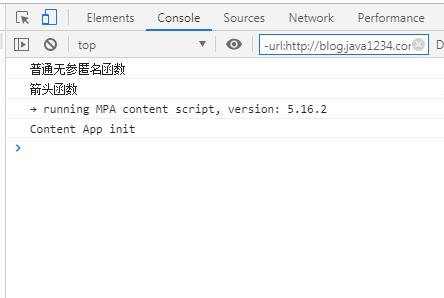
es6箭头函数以及this
es6箭头函数
es6推出了箭头函数,用来简化定义匿名函数;
基本语法:
let func1=function(){
console.log('普通无参匿名函数');
}
func1();
let func2=()=>console.log('箭头函数');
func2();执行效果一样:

let func2=()=>console.log('箭头函数');
这个括号是方法参数,里面可以写形参;=>后面的内容是方法体;
假如有一个参数的时候,这么写:
let func3=(c)=>console.log('箭头函数,一个参数');
func3('参数一');
当然一个参数的时候,括号可以省略(我个人习惯,还是不省略,不然看着别扭)
let func4=c=>console.log('箭头函数,一个参数,括号可以省略');
func4('参数一');
// 两个或者两个以上参数情况 (括号不能省略)
let func5=(a,b)=>console.log(a,b);
func5(1,2);
// 箭头函数,只有一条语句,可以省略大括号{}
let func6=()=>{
console.log('箭头函数,只有一条语句,可以省略大括号{}');
}
func6();
// 函数体,多条语句,要用大括号{}
let func7=(a,b)=>{
let c=a+b;
return c;
}
console.log(func7(1,2));
// 特殊情况 假如不加花括号,表达式返回最终结果;
let func8=(a,b)=>a+b
console.log(func8(1,4));
// 重要特性 箭头函数没有this,所以this是定义的时候,外部所在的对象是它的this。不是调用的时候的this;
let name='marry';
let obj={
name:'jack',
age:20,
/*getName:()=>{
console.log(this.name)
}*/
getName:function(){
/* document.getElementById('btn').onclick=()=>{
console.log(this)
}*/
console.log(this.name)
},
getName2:function(){
document.getElementById('btn').onclick=function(){
console.log(this)
}
console.log(this.name)
}
};
obj.getName();
obj.getName2();


- Java核心基础(145)
- QQ第三方登录(6)
- mybatis-plus(20)
- Mycat(30)
- Layui(2)
- Mysql(2)
- Docker(35)
- Dubbo(7)
- 007项目(0)
- SVN(22)
- SpringCloud(33)
- Tomcat(6)
- 支付宝接口(3)
- NodeJs(1)
- IDEA(24)
- SpringBoot(11)
- 微信扫码登录(4)
- Git(50)
- Nginx(24)
- Vue.js(50)
- jsoup(6)
- shiro(1)
- Redis(17)
- maven(6)
- 活动(20)
- hibernate(1)
- EhCache缓存框架(4)
- webservice(10)
- CAS单点登录(7)
- elasticsearch(31)
- log4j日志(8)
- IT之路(26)
- activiti(26)
- centos(25)
- java爬虫技术(14)
- 随心生活(19)
- 网站SEO(2)
- htmlunit(10)
- httpclient(7)
- 2022年12月(1)
- 2021年10月(1)
- 2021年02月(3)
- 2020年11月(3)
- 2020年10月(4)
- 2020年09月(7)
- 2020年08月(18)
- 2020年07月(21)
- 2020年06月(37)
- 2020年05月(17)
- 2020年04月(12)
- 2020年03月(10)
- 2020年02月(14)
- 2020年01月(12)
- 2019年12月(15)
- 2019年11月(27)
- 2019年10月(5)
- 2019年09月(1)
- 2019年08月(4)
- 2019年07月(28)
- 2019年06月(16)
- 2019年05月(4)
- 2019年04月(3)
- 2019年03月(2)
- 2019年02月(7)
- 2019年01月(20)
- 2018年12月(2)
- 2018年11月(5)
- 2018年10月(30)
- 2018年09月(11)
- 2018年08月(5)
- 2018年07月(9)
- 2018年06月(4)
- 2018年05月(4)
- 2018年04月(3)
- 2018年03月(7)
- 2018年02月(6)
- 2018年01月(13)
- 2017年12月(3)
- 2017年11月(10)
- 2017年10月(1)
- 2017年09月(9)
- 2017年08月(12)
- 2017年07月(19)
- 2017年06月(21)
- 2017年05月(1)
- 2017年04月(12)
- 2017年03月(13)
- 2017年02月(12)
- 2017年01月(14)
- 2016年12月(8)
- 2016年11月(25)
- 2016年10月(16)
- 2016年09月(13)
- 2016年08月(20)
- 2016年07月(12)
- 2016年06月(36)
- 2016年05月(10)
- 2016年04月(19)
- 2016年03月(14)
- 2016年02月(23)
- 2016年01月(1)